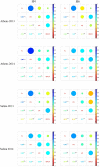Comparative evolution of vegetative branching in sorghum
- PMID: 34388196
- PMCID: PMC8362987
- DOI: 10.1371/journal.pone.0255922
Comparative evolution of vegetative branching in sorghum
Abstract
Tillering and secondary branching are two plastic traits with high agronomic importance, especially in terms of the ability of plants to adapt to changing environments. We describe a quantitative trait analysis of tillering and secondary branching in two novel BC1F2 populations totaling 246 genotypes derived from backcrossing two Sorghum bicolor x S. halepense F1 plants to a tetraploidized S. bicolor. A two-year, two-environment phenotypic evaluation in Bogart, GA and Salina, KS permitted us to identify major effect and environment specific QTLs. Significant correlation between tillering and secondary branching followed by discovery of overlapping sets of QTLs continue to support the developmental relationship between these two organs and suggest the possibility of pleiotropy. Comparisons with two other populations sharing S. bicolor BTx623 as a common parent but sampling the breadth of the Sorghum genus, increase confidence in QTL detected for these two plastic traits and provide insight into the evolution of morphological diversity in the Eusorghum clade. Correspondence between flowering time and vegetative branching supports other evidence in suggesting a pleiotropic effect of flowering genes. We propose a model to predict biomass weight from plant architecture related traits, quantifying contribution of each trait to biomass and providing guidance for future breeding experiments.
Conflict of interest statement
The authors have declared that no competing interests exist.
Figures





References
Publication types
MeSH terms
LinkOut - more resources
Full Text Sources

